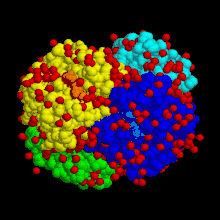Konjugiertes Protein
Ein konjugiertes Protein (auch Heteroprotein oder Proteid) ist ein Protein, das ein anderes Nichtprotein-Molekül gebunden hat.[1] Im Gegensatz dazu bestehen multimere Proteine aus mehreren Proteinbestandteilen.

Das mit Häm konjugierte Protein Hämoglobin mit vier unterschiedlich gefärbten Untereinheiten
Eigenschaften
Konjugierte Proteine sind z. B. Lipoproteine, Glycoproteine, Phosphoproteine, Hämproteine, Flavoproteine, Ribonukleoproteine, Metalloproteine, Phytochrome, Cytochrome und Opsine. Der Nichtprotein-Anteil eines konjugierten Proteins kann eine posttranslationale Modifikation oder eine prosthetische Gruppe sein.
Im Zuge einer Molekülmarkierung können in vitro unterschiedliche Moleküle mit Proteinen konjugiert werden.[2]
Literatur
- David L. Nelson, Michael M. Cox: Lehninger Biochemie. 4. Auflage. Springer, Berlin / Heidelberg 2009, ISBN 978-3-540-68637-8.
Einzelnachweise
- G. Wald: CAROTENOIDS AND THE VISUAL CYCLE. In: The Journal of general physiology. Band 19, Nummer 2, November 1935, S. 351–371, PMID 19872932. PMC 2141433 (freier Volltext).
- D. Pfister, M. Morbidelli: Process for protein PEGylation. In: Journal of controlled release : official journal of the Controlled Release Society. Band 180, April 2014, S. 134–149, doi:10.1016/j.jconrel.2014.02.002. PMID 24531008.
This article is issued from Wikipedia. The text is licensed under Creative Commons - Attribution - Sharealike. The authors of the article are listed here. Additional terms may apply for the media files, click on images to show image meta data.